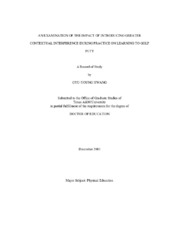An examination of the impact of introducing greater contextual interference during practice on learning to golf putt
Abstract
The skill of putting in golf contributes approximately 40 percent to one’s total score making it an important skill to master in golf. One of the critical means of improving putting skill is through practice. The purpose of this study was to: (a) investigate if different practice schedules with different degrees of contextual interference (CI) influenced the participants’ immediate and long-term putting performance, (b) examine if performance changes were associated with concomitant changes in specific kinematic parameters, and (c) assess the cognitions of the participants during various stages of the practice of the putting skill.
Twenty-four undergraduate students were randomly assigned to either a blocked or random practice schedule. On Day One each participant practiced putting to three targets (4 ft, 8 ft, and 12 ft distance) for a total of 108 trials (36 trials to each target). On Day Two 30 trials of retention (10 trials to each target) and 10 transfer trials (10 ft distance) were performed. To obtain a kinematic description of the putting action, an OPTOTRAKTM 3020 camera system recorded the 3D movement of the putter. Participants’ cognitions were analyzed from stimulated recall interview data. Random practice participants exhibited poorer putting performance during acquisition compared to their blocked practice counterparts but showed superior performance in retention and transfer tests. While the blocked practice participants had significantly lower variability in the amplitude in the x-dimension for backswing, impact velocity, and putter position at impact (z-dimension) during practice, the random practice participants showed significantly lower variability in the amplitude of the x-dimension for the backswing and downswing, impact velocity, and putter position at impact during the retention and transfer phases.
Content analysis of interview data yielded three emergent categories: participant focus, self-evaluation of performance, and benefits of practice. The participants provided evidence of active thought processes during the putting task while receiving little instruction. The blocked group focused more on accuracy while the random group was more focused on judging distance. The lack of recognition about the z-dimension has potential implications for how instruction and feedback might be employed during the learning process.
Citation
Hwang, Gyu-Young (2003). An examination of the impact of introducing greater contextual interference during practice on learning to golf putt. Doctoral dissertation, Texas A&M University. Texas A&M University. Available electronically from https : / /hdl .handle .net /1969 .1 /1608.


